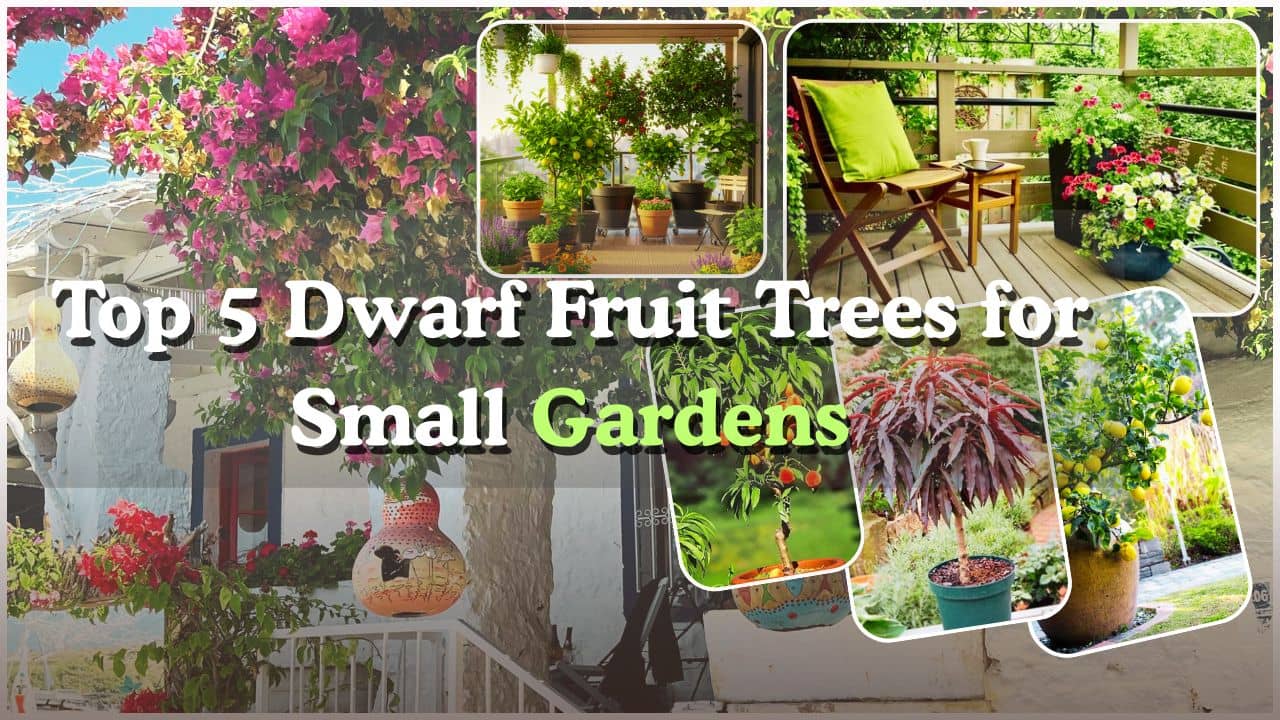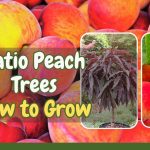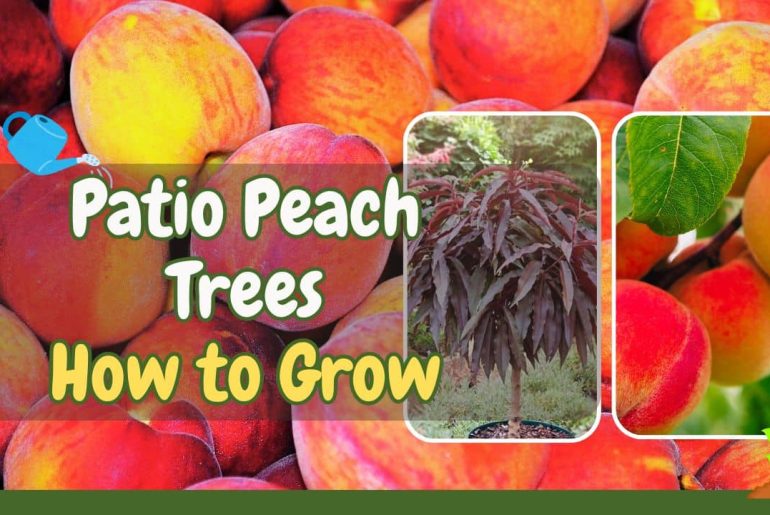Ever dreamed of plucking fresh apples, lemons, or peaches straight from your own backyard—but thought you didn’t have enough space?
You’re not alone.
Across the U.S., more people are turning small patios, balconies, and courtyards into lush green oases filled with edible plants. And the secret? Dwarf fruit trees.
These compact trees deliver the same delicious fruit as their full-sized cousins—without taking over your entire garden. Whether you live in a suburban home, a townhouse, or even an apartment with a sunny balcony, you can enjoy homegrown fruit year-round.
In this post, we’ll explore the Top 5 Dwarf Fruit Trees for Small Gardens, plus essential care tips, design ideas, and where to buy them.
Let’s dig in! 🌱
Table of Contents
🌿 Why Choose Dwarf Fruit Trees?
- Space-Saving: Perfect for limited spaces, decks, or even balconies.
- Fast Fruiting: Many start bearing fruit within 1–3 years.
- Easier Care: Pruning, watering, and harvesting are more accessible.
- Beautiful Design Element: Adds color, shade, and life to any small garden.
- Container Friendly: Move them indoors during colder months.
“You can learn more how to grow Patio peach trees at this article”.
Ideal Growing Conditions
Most dwarf fruit trees love full sun (6–8 hours daily) and well-draining soil.
For container growers: choose pots with drainage holes and use a mix of compost and high-quality potting soil.
“The Royal Horticultural Society provides detailed advice on caring for container-grown fruit trees.”
🍎 Top 5 Dwarf Fruit Trees for Small Gardens
🍏 1. Dwarf Apple Tree (‘Honeycrisp’ or ‘Fuji’)
If you’ve always dreamed of having your own apple tree but thought you didn’t have enough room — the dwarf apple tree is your answer. Varieties like ‘Honeycrisp’ and ‘Fuji’ are ideal for small gardens, patios, or even sunny balconies. Despite their smaller size, they produce full-sized, juicy apples with a crisp texture and sweet flavor.
Dwarf apple trees grow to about 6–8 feet tall, making them easy to manage and harvest without ladders. The ‘Honeycrisp’ variety is known for its refreshing crunch and balanced sweetness, while ‘Fuji’ offers a honey-like flavor and extended shelf life — perfect for snacking or baking.
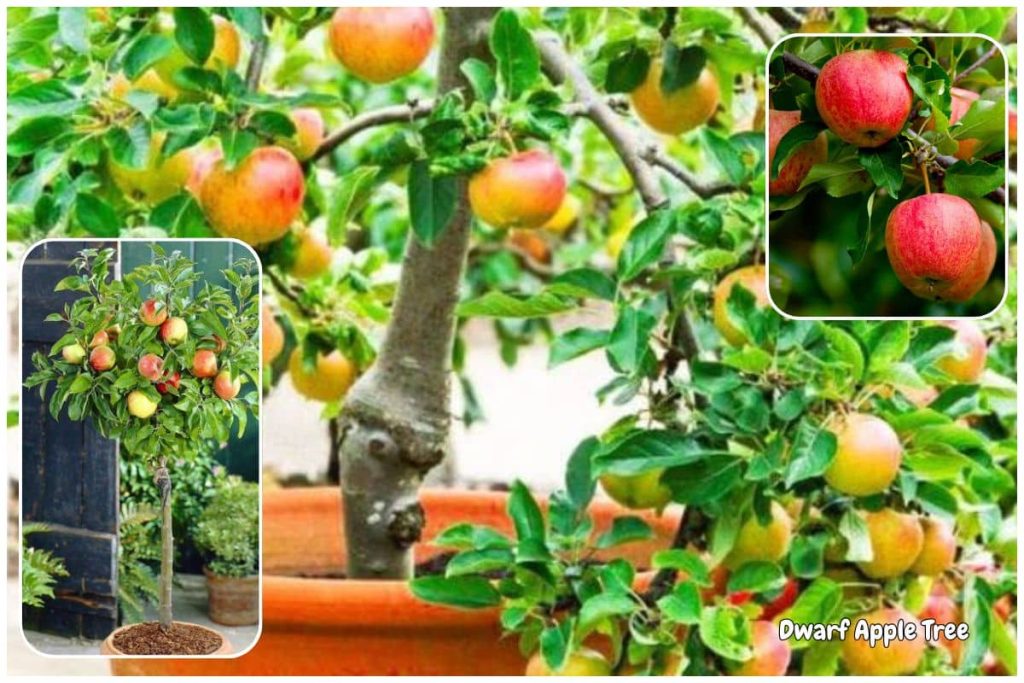
🌎 Ideal Growing Conditions
- USDA Hardiness Zones: 4–8
- Sunlight: Full sun (at least 6–8 hours daily)
- Soil: Well-draining loamy soil enriched with organic matter
- Container Size: Minimum 15–20 gallons if growing in pots
- Pollination: Plant two compatible apple varieties nearby for best yields (e.g., Honeycrisp + Fuji)
🌼 Growing Tips
- Planting: Set your dwarf apple tree in early spring after frost has passed. If planting in a container, use a high-quality potting mix with compost and perlite.
- Watering: Keep soil evenly moist — about once a week — but avoid soggy conditions that cause root rot.
- Fertilizing: Apply a balanced 10-10-10 fertilizer or organic compost in early spring and midsummer.
- Pruning: Prune in late winter to remove crossing branches and encourage airflow. This keeps the tree healthy and fruiting consistently.
- Pest Control: Watch for aphids or codling moths. Neem oil or organic insecticidal soap can help manage them naturally.
🍎 Harvest & Storage
You’ll typically enjoy your first harvest 2–3 years after planting. Apples are ready to pick when they come off the branch easily and have a rich color. Store them in a cool, dry place — or refrigerate for longer freshness.
🌱 Pro Tip
Pair your dwarf apple tree with pollinator-friendly plants like lavender or chives. They attract bees and help improve fruit set naturally! 🐝
🍋 2. Dwarf Lemon Tree (‘Meyer Lemon’)
The dwarf Meyer lemon is a compact hybrid between a lemon and a mandarin orange, known for its rich aroma and smooth, thin-skinned fruit. It grows to about 5–7 feet tall, making it ideal for containers, balconies, or sunny kitchen corners.
Unlike traditional lemons, Meyer lemons are less acidic and more floral, perfect for cooking, baking, or even homemade lemonade.
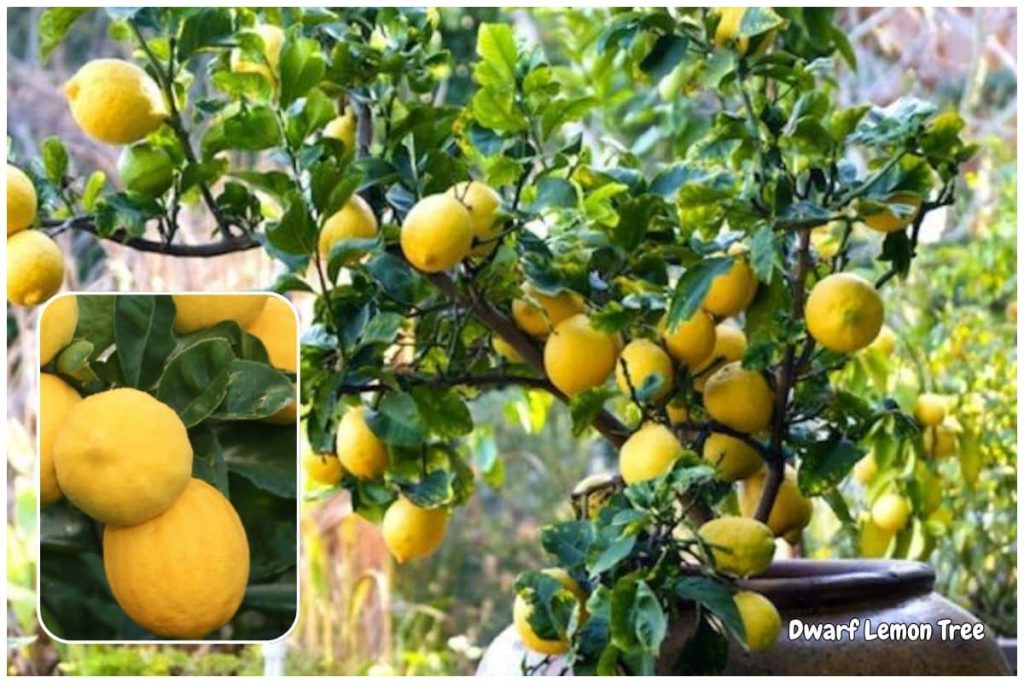
🌎 Ideal Growing Conditions
- USDA Hardiness Zones: 8–11
- Sunlight: Full sun (8+ hours daily)
- Soil: Slightly acidic, well-drained potting mix
- Container Size: At least 10–15 gallons with good drainage
- Indoor/Outdoor Use: Move indoors during winter in cooler climates
🌼 Growing Tips
- Planting: Use a pot with drainage holes and elevate slightly with pot feet to prevent soggy roots.
- Watering: Keep the soil moist but not soggy. Water deeply when the top inch feels dry.
- Feeding: Use a citrus-specific fertilizer every 4–6 weeks during the growing season.
- Pruning: Prune lightly after fruiting to shape and encourage airflow.
- Pollination: If grown indoors, hand-pollinate blossoms with a small paintbrush to ensure fruit set.
🍋 Harvest & Storage
Meyer lemons can fruit year-round, especially when kept in stable indoor temperatures. The fruit turns deep yellow and feels slightly soft when ripe.
🌱 Pro Tip
Place your tree near a south-facing window indoors for maximum sunlight — and enjoy the heavenly scent of lemon blossoms even in winter. 🌞
🍑 3. Dwarf Peach Tree (‘Bonanza’ Peach)
Dwarf peach tree is self-fertile variety grows to a modest 5–6 feet tall but produces full-sized, sweet peaches. Its attractive pink blossoms in spring make it as ornamental as it is productive.
The Bonanza Peach tree is perfect for container gardening, adding both beauty and bounty to your outdoor area.
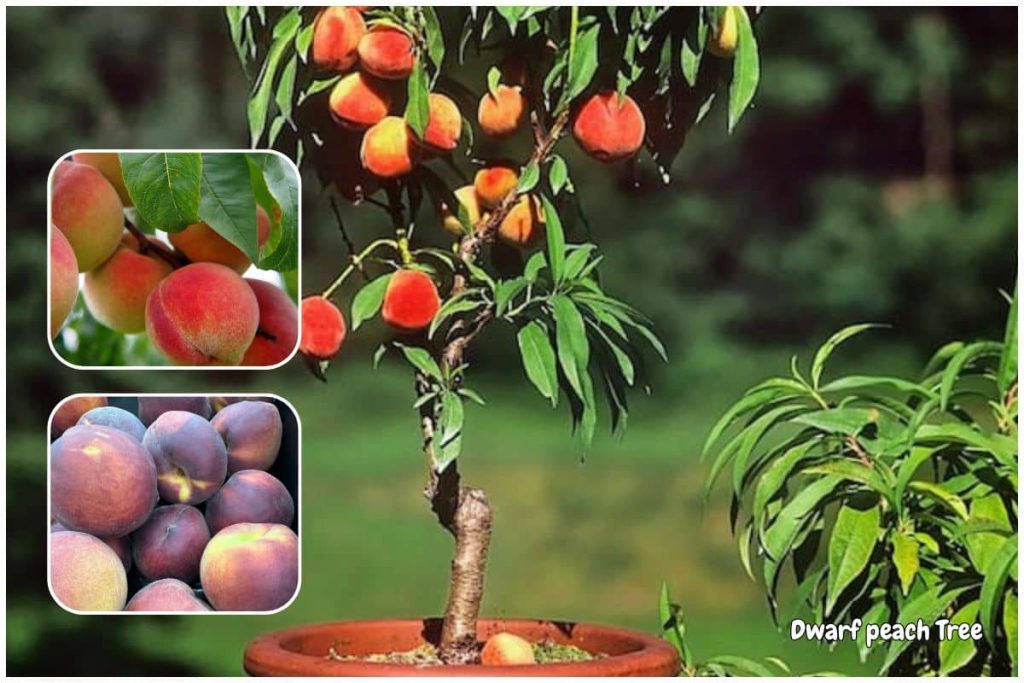
🌎 Ideal Growing Conditions
- USDA Hardiness Zones: 6–9
- Sunlight: Full sun (6–8 hours daily)
- Soil: Well-drained, sandy loam enriched with compost
- Container Size: 15–20 gallons minimum
🌼 Growing Tips
- Planting: Choose a warm, sunny spot protected from cold winds.
- Watering: Deeply water every 7–10 days during the growing season. Avoid wetting leaves to prevent fungal diseases.
- Fertilizing: Apply organic compost or fruit tree fertilizer in early spring.
- Pruning: After harvest, prune lightly to maintain shape and encourage new growth.
- Pest Watch: Keep an eye out for peach leaf curl—treat in early spring with an organic copper fungicide.
🍑 Harvest & Storage
Peaches ripen in mid to late summer, depending on your region. They should detach easily when gently lifted and twisted. Fresh peaches last about a week in the fridge or can be frozen for smoothies and desserts.
🌱 Pro Tip
Mulch around the tree’s base to conserve moisture and regulate soil temperature. Your peaches (and your back) will thank you later! 🍑
🍒 4. Dwarf Cherry Tree (‘Stella’ or ‘Compact Stella’)
For gardeners who love a burst of sweetness in summer, the Stella Dwarf Cherry Tree is a fantastic choice. Compact, self-pollinating, and incredibly productive, this tree gives you buckets of rich, red cherries — even if your “garden” is a patio.
The ‘Stella’ and ‘Compact Stella’ are prized for their manageable size (just 7–10 feet tall) and delicious, dark-red cherries. These trees bloom beautifully in spring with pink-white flowers and fruit abundantly by early summer.
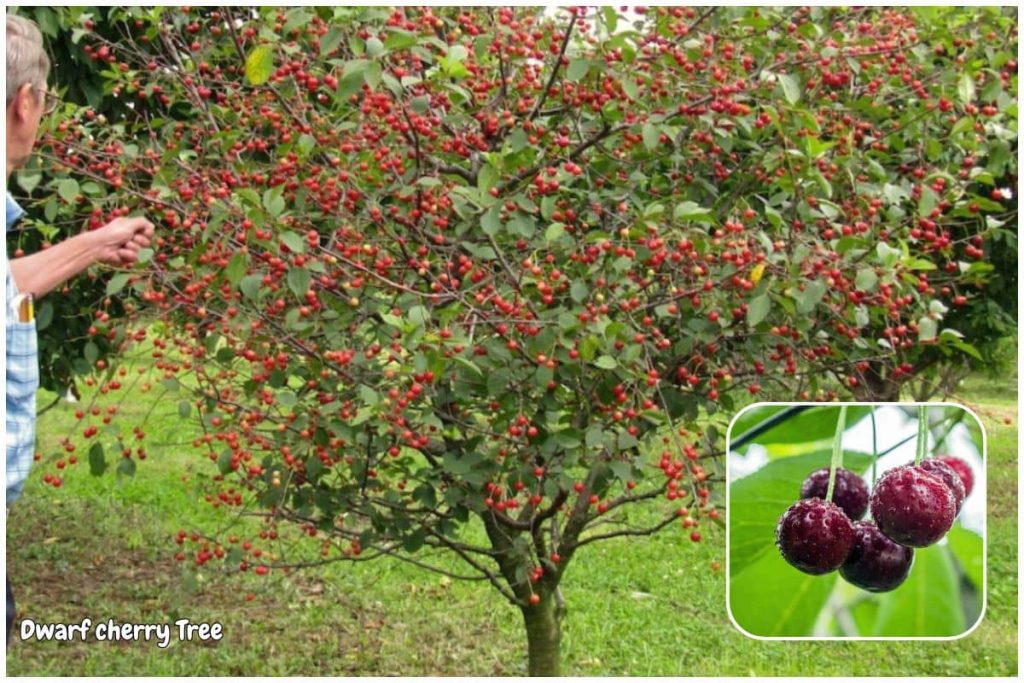
🌎 Ideal Growing Conditions
- USDA Hardiness Zones: 5–9
- Sunlight: Full sun (6–8 hours daily)
- Soil: Well-drained loam, slightly acidic (pH 6.0–6.5)
- Container Size: 20 gallons minimum for potted trees
🌼 Growing Tips
- Planting: Early spring is best; choose a spot with good air circulation.
- Watering: Keep the soil evenly moist, watering deeply once a week.
- Feeding: Use a balanced fertilizer in early spring before bloom.
- Pruning: Prune annually in late winter to open the canopy and remove dead wood.
- Bird Protection: Use netting during fruiting season to keep hungry birds away.
🍒 Harvest & Storage
Cherries are ready when deep red and slightly soft to the touch—usually in late spring to early summer. Harvest by cutting, not pulling, to protect the branches.
🌱 Pro Tip
Planting lavender or marigolds nearby helps deter pests and adds a colorful companion to your cherry tree corner. 🌸
🍈 5. Dwarf Fig Tree (‘Little Miss Figgy’ or ‘Petite Negra’)
Varieties like ‘Little Miss Figgy’ and ‘Petite Negra’ stay compact—around 3–5 feet tall—and bear small, sweet figs that are perfect for fresh eating or preserves. The leaves are large and ornamental, making this tree as decorative as it is delicious.
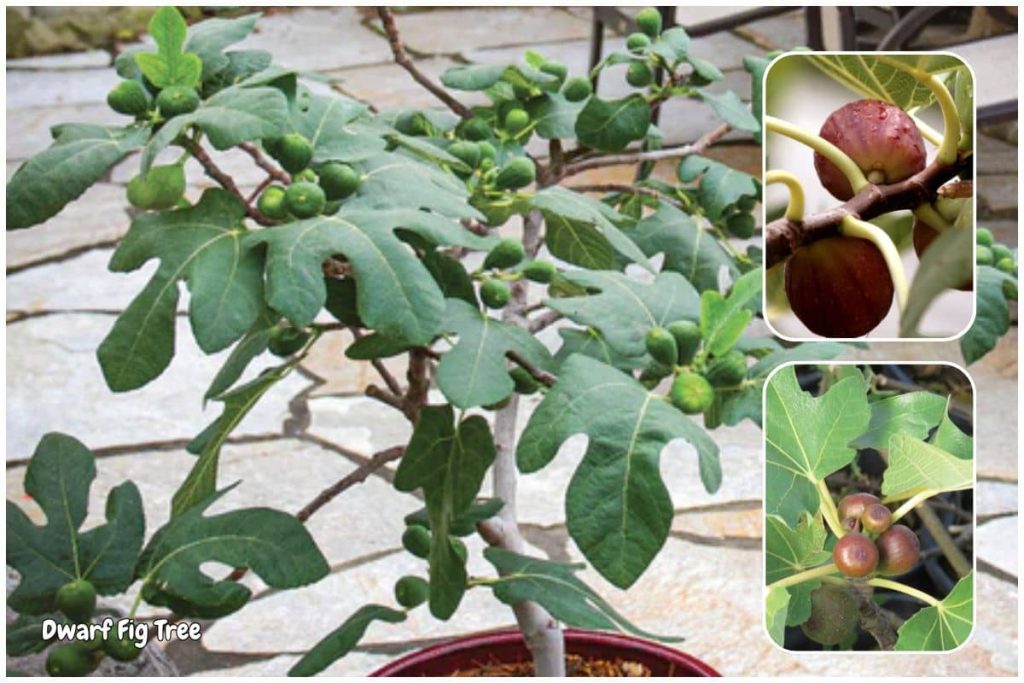
🌎 Ideal Growing Conditions
- USDA Hardiness Zones: 7–10
- Sunlight: Full sun (at least 6 hours daily)
- Soil: Well-draining sandy or loamy mix
- Container Size: 10–15 gallons, with room for roots to spread
🌼 Growing Tips
- Planting: Use a wide pot for root expansion. Plant in spring once frost risk passes.
- Watering: Keep soil slightly moist; figs dislike “wet feet.”
- Feeding: Fertilize with balanced organic compost in spring and midsummer.
- Pruning: Prune after harvest to control size and encourage new shoots.
- Winter Care: Move containers indoors or insulate roots with mulch in colder regions.
🍈 Harvest & Storage
Figs typically produce two harvests per year—an early “breba” crop in summer and a second in fall. Ripe figs feel soft and droop slightly from the stem. Eat them fresh or dry them for long-term storage.
🌱 Pro Tip
Grow figs near a warm wall or fence to trap heat and boost fruit ripening — they love cozy spots! ☀️
“You can find a wide selection of dwarf apple, lemon, and peach trees online at FastGrowingTrees.com.”
🌼 Design Ideas for Small Gardens
🌿 Creative Ways to Incorporate Dwarf Fruit Trees in Small Spaces
Just because your garden space is limited doesn’t mean your creativity has to be! With a few clever design ideas, you can turn even the smallest patio, balcony, or backyard corner into a lush, fruit-filled paradise. Dwarf fruit trees not only produce delicious harvests but also bring color, texture, and structure to compact spaces.
Let’s explore a few creative, space-smart design ideas that blend beauty with functionality.
you can learn more reviews of Dwarf fruit trees for small gardens and balconies available on Facebook.
1. Vertical with Trellises and Walls
When horizontal space is scarce, think upward!
Vertical gardening is a game-changer for urban gardeners. Use trellises, espalier techniques, or wall-mounted planters to train your dwarf fruit trees to grow flat against fences or walls.
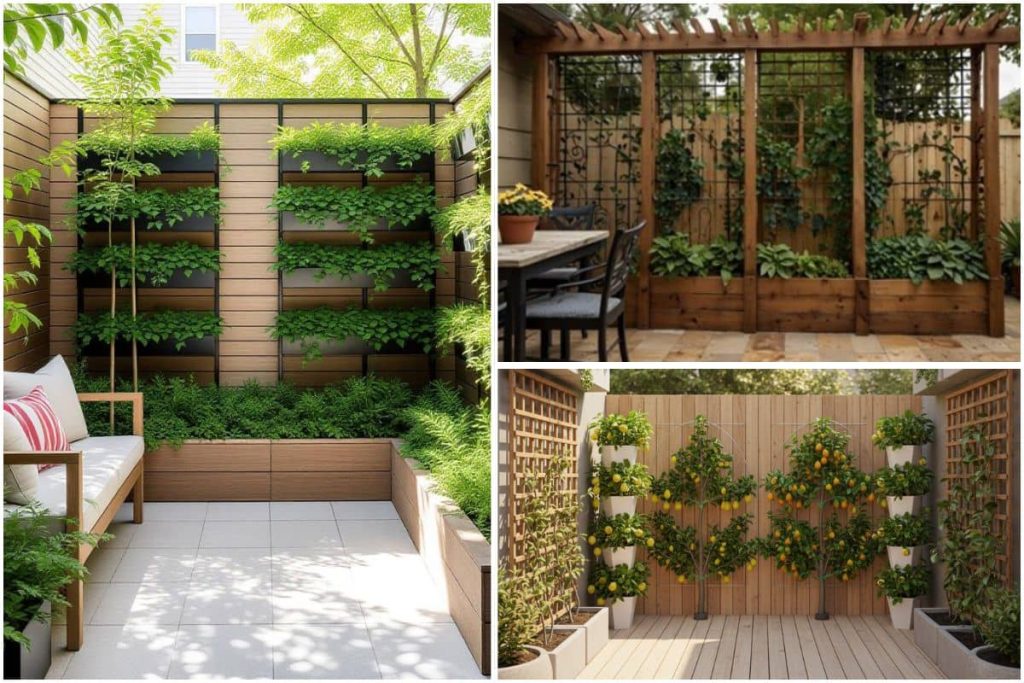
- Espaliered Apple or Pear Trees: These are pruned and trained to grow in decorative patterns—perfect along fences or behind raised beds.
- Vertical Citrus Towers: Stackable planters or narrow, upright containers make it easy to grow Meyer lemons or dwarf oranges without taking over your floor space.
- Trellised Peach or Fig Trees: Lightweight trellises can support branches while allowing air circulation and sunlight access.
Pro Tip: Choose sturdy trellises and soft ties to gently guide your tree’s branches without damaging them.
🌸 2. Mix Fruit Trees with Flowers and Herbs
Who says fruit trees have to stand alone? Blending dwarf fruit trees with colorful flowers and aromatic herbs creates a multi-layered, sensory garden that’s as beautiful as it is productive.
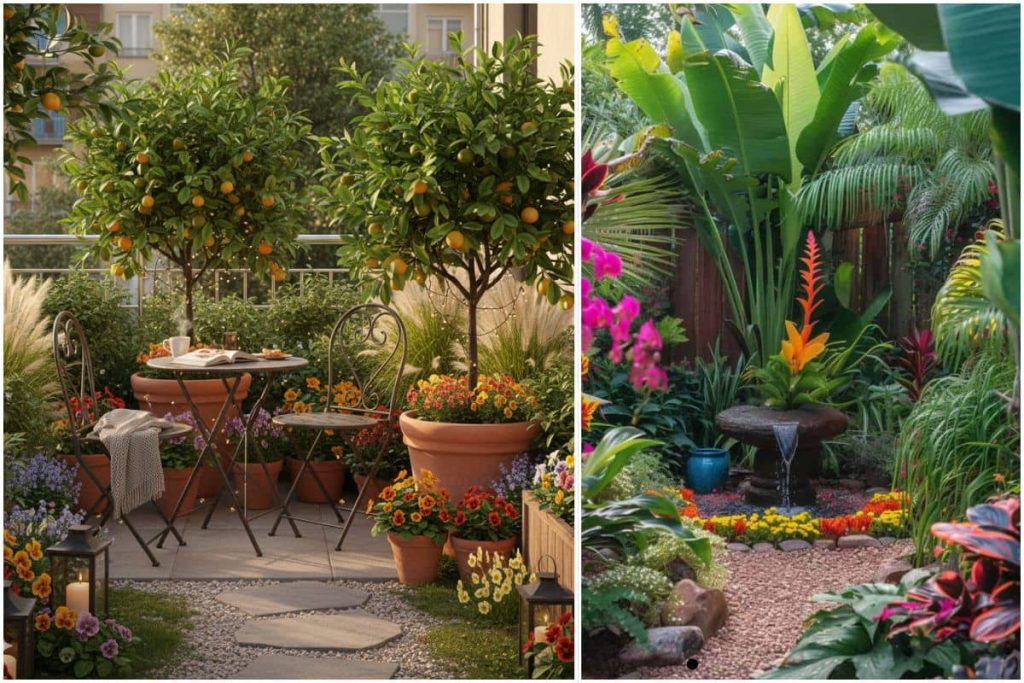
Try pairing your dwarf fruit trees with companion plants that:
- Attract Pollinators: Lavender, marigolds, and salvia bring in bees and butterflies.
- Repel Pests Naturally: Basil, rosemary, and chives deter aphids and fruit flies.
- Add Visual Interest: Pair bright herbs with dwarf peach or fig trees for stunning contrast.
Design Idea: Create a “fruit and fragrance corner” with a Meyer lemon tree surrounded by rosemary, thyme, and lavender — a mix that looks, smells, and tastes amazing!
🌿 3. Small-Space Patio and Balcony Layouts
Your balcony or patio can double as a mini orchard with the right setup. Use containers, tiered plant stands, and hanging planters to create depth and maximize sunlight exposure.
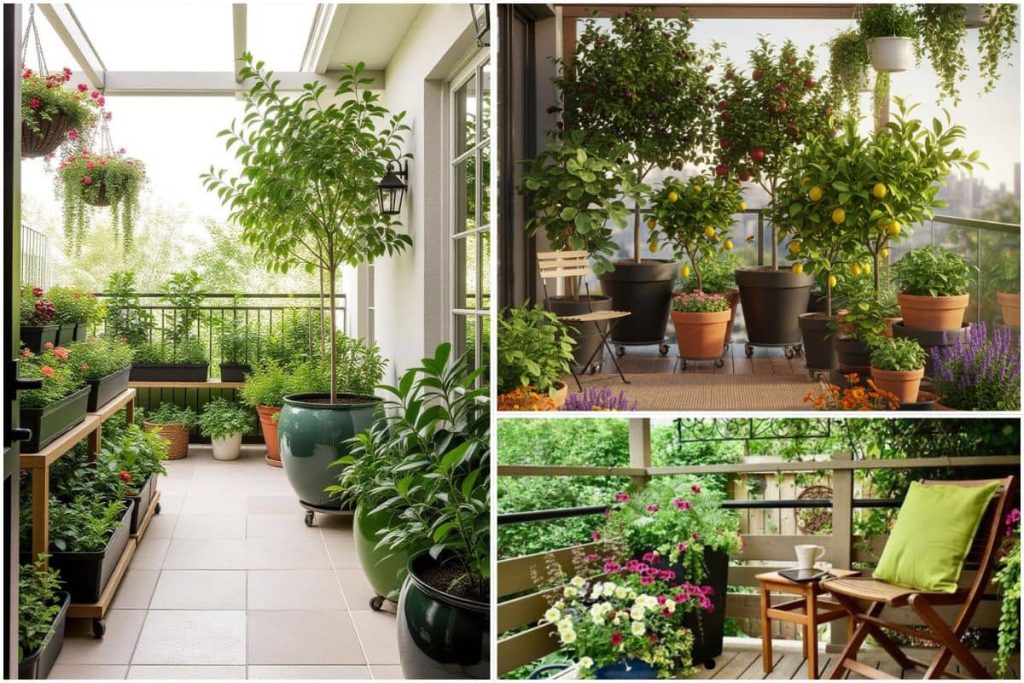
Here’s how:
- Place taller dwarf fruit trees (like apples or cherries) at the back.
- Add medium plants (lemons, figs) in the middle.
- Layer low-growing herbs or flowers around the base for a finished look.
Consider grouping your plants in matching containers for a cohesive, polished aesthetic.
Use lightweight pots with wheels or casters — this way, you can easily move trees to chase sunlight or protect them from wind.
Pro Tip: For patios with limited sunlight, choose fruit trees like figs or Meyer lemons that tolerate partial shade better than others.
🌺 4. Create a Multi-Sensory Garden Corner
Incorporate textures, scents, and colors to make your small garden feel larger and more alive. Combine fragrant dwarf citrus trees, soft ornamental grasses, and edible flowers like nasturtiums or pansies.
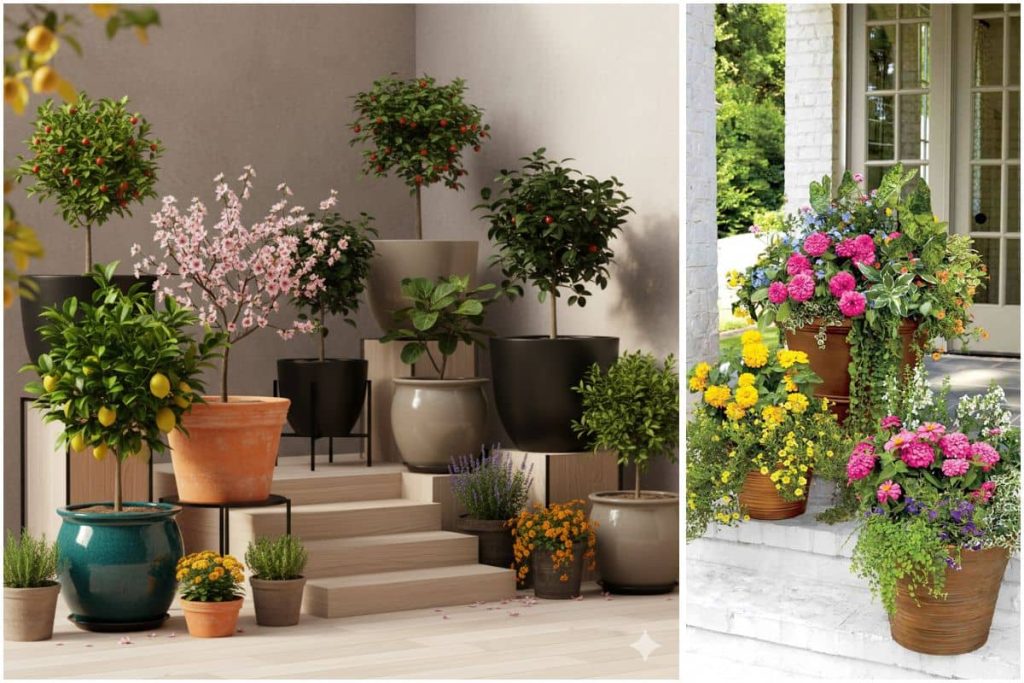
- Add a small bistro set or garden bench beneath your trees for a cozy retreat.
- Use solar fairy lights around tree pots for nighttime ambiance.
- Include stepping stones or gravel pathways to define zones, even in small spaces.
This turns your balcony or yard into a relaxing oasis — a perfect morning coffee or sunset reading spot surrounded by your own fruit harvests. 🍋📖
🌾 5. Use Decorative Containers and Planters
Since dwarf trees spend much of their lives in pots, make your containers part of the design!
- Choose ceramic, terracotta, or wood planters for rustic charm.
- Go modern with sleek, matte black or neutral fiberglass containers.
- Add matching saucers and plant stands for symmetry and style.
Pro Tip: Use different heights of planters to create dimension and visual flow — like a natural fruit “staircase.”
🛒 Where to Buy Dwarf Fruit Trees
When you’re ready to bring your garden to life, start with trusted nurseries known for quality rootstock.
Recommended Nurseries (USA)
- FastGrowingTrees.com – Wide selection and delivery-friendly packaging.
- Stark Bro’s Nurseries – Trusted since 1816, great for heritage fruit trees.
- Nature Hills Nursery – Specializes in dwarf and patio-sized trees.
“Before selecting your dwarf fruit trees, consult the USDA Plant Hardiness Zone Map to confirm which varieties thrive in your region.”
Conclusion
Who says you need acres of land to enjoy the sweetness of homegrown fruit? 🌳
With dwarf fruit trees, anyone — whether you live in a cozy apartment, a townhouse with a small patio, or a suburban home with limited yard space — can experience the joy of harvesting fresh, flavorful fruit straight from your own garden. If you’ve been hesitating because you think you don’t have the “right space” or enough experience — this is your sign to start small.
Pick one or two varieties that excite you. Maybe a Meyer Lemon Tree for your sunny balcony, or a Honeycrisp Apple Tree for your backyard corner. Watch them grow, blossom, and reward you with fruit that tastes sweeter simply because you grew it yourself.
Gardening isn’t just about the harvest — it’s about slowing down, connecting with nature, and creating something beautiful right where you are.
How much sunlight do dwarf fruit trees need?
At least 6–8 hours of direct sunlight daily for healthy growth and maximum yield.
What are the best dwarf fruit trees for small gardens?
The best include dwarf apple, lemon, peach, cherry, and fig trees—ideal for limited spaces and container growing.
Where can I buy dwarf fruit trees in the USA?
Reputable sources include FastGrowingTrees, Stark Bro’s, and Nature Hills Nursery.


